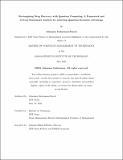Re-imagining Drug Discovery with Quantum Computing: A Framework and Critical Benchmark Analysis for achieving Quantum Economic Advantage
Author(s)
Galatsanos-Dueck, Johannes
DownloadThesis PDF (5.896Mb)
Advisor
Cusumano, Michael A.
Terms of use
Metadata
Show full item recordAbstract
Quantum computing’s (QC) promise of solving computationally hard problems has captured public attention and imagination, leading to significant private and public capital investments in recent years. At the same time, we are at the cusp of a biomedical revolution powered by computer-aided drug discovery (CADD). Drug discovery companies are rapidly transitioning to the use of artificial intelligence to expedite and enhance research and development. However, many of the classical AI use cases scale exponentially fast and face computational power ceilings. QC can potentially accelerate these processes by several orders of magnitude in the future. As such, an open question for drug discovery companies is when and how to adopt QC.
This thesis summarizes quantum CADD methods and useful applications in drug discovery. The current state and trajectory of quantum computing is critically analyzed based on multiple benchmarks and manufacturer roadmaps. Furthermore, 11 industry decision-makers were interviewed to identify the current behaviors of end customers in investing in QC. To answer the question of correct timing and sizing of investments for a drug discovery company, the concept of net quantum economic advantage is introduced, considering all direct and indirect costs and benefits. A framework for drug discovery companies to monitor and invest in QC to reach a net quantum economic advantage is provided.
The most useful QC algorithms of Quantum Phase Estimation and Quantum Machine Learning for CADD will provide practical value after >2000 logical qubits and circuit sizes of >1011 gates, a far cry from today’s performance of single-digit logical qubits. Based on manufacturer timelines, these benchmarks may be achieved in the mid-2030s. However, other use cases might become interesting in the next years, and preparing a company to take advantage of QC has a long lead time. As such, drug discovery companies should move to an active quantum monitoring phase soon.
Date issued
2024-05Department
Sloan School of ManagementPublisher
Massachusetts Institute of Technology